With the Night Mail (1)
By:
March 21, 2012
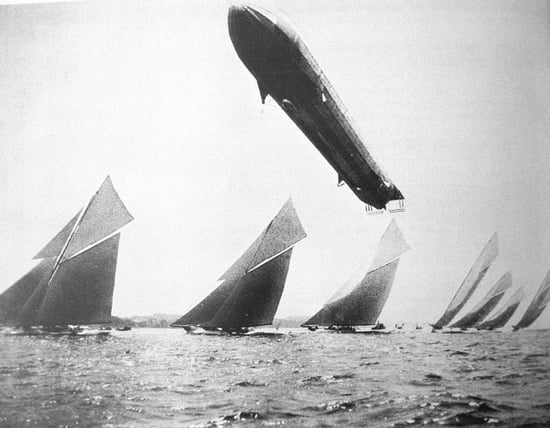
HILOBROW is pleased to present the first installment of our serialization of Rudyard Kipling’s With the Night Mail (and his follow-up story, “As Easy as A.B.C.”). New installments will appear each Wednesday for 12 weeks.
With the Night Mail follows the exploits of an intercontinental mail dirigible battling the perfect storm. Between London and Quebec we learn that a planet-wide Aerial Board of Control (A.B.C.) now enforces a technocratic system of command and control not only in the skies but in world affairs, too. A follow-up story, “As Easy As A.B.C.,” recounts what happens when agitators in Chicago demand a return of democracy: The A.B.C. sends zeppelins armed with sound weapons to subdue not the agitators, but a mob who would destroy them! With the Night Mail is set in 2000, and it first appeared in 1905; 2012 marks the centennial of the first publication of “As Easy As A.B.C.”
In June, HiLoBooks will publish a beautiful new edition of With the Night Mail (and “As Easy as A.B.C.”), checked against the 1909 first published edition (Doubleday), with an Introduction by science fiction author Matthew De Abaitua, and an Afterword by science fiction author Bruce Sterling. SUPPLIES ARE LIMITED! CLICK HERE TO ORDER YOUR COPY.
SUBSCRIBE to HILOBROW’s serialized fiction via RSS.
ALL EXCERPTS: 1 | 2 | 3 | 4 | 5 | 6 | 7 | 8 | 9 | 10 | 11 | 12
At nine o’clock of a gusty winter night I stood on the lower stages of one of the G.P.O. outward mail towers. My purpose was a run to Quebec in “Postal Packet 162 or such other as may be appointed”; and the Postmaster-General himself countersigned the order. This talisman opened all doors, even those in the despatching-caisson at the foot of the tower, where they were delivering the sorted Continental mail. The bags lay packed close as herrings in the long gray under-bodies which our G. P. O. still calls “coaches.” Five such coaches were filled as I watched, and were shot up the guides to be locked on to their waiting packets three hundred feet nearer the stars.
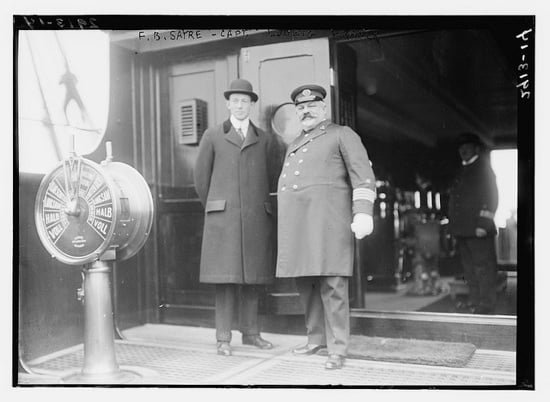
From the despatching-caisson I was conducted by a courteous and wonderfully learned official —Mr. L. L. Geary, Second Despatcher of the Western Route — to the Captains’ Room (this wakes an echo of old romance), where the mail captains come on for their turn of duty. He introduces me to the Captain of “162”—Captain Purnall, and his relief, Captain Hodgson. The one is small and dark; the other large and red; but each has the brooding sheathed glance characteristic of eagles and aëronauts. You can see it in the pictures of our racing professionals, from L. V. Rautsch to little Ada Warrleigh — that fathomless abstraction of eyes habitually turned through naked space.
On the notice-board in the Captains’ Room, the pulsing arrows of some twenty indicators register, degree by geographical degree, the progress of as many homeward-bound packets. The word “Cape” rises across the face of a dial; a gong strikes: the South African mid-weekly mail is in at the Highgate Receiving Towers. That is all. It reminds one comically of the traitorous little bell which in pigeon-fanciers’ lofts notifies the return of a homer.
“Time for us to be on the move,” says Captain Purnall, and we are shot up by the passenger-lift to the top of the despatch-towers. “Our coach will lock on when it is filled and the clerks are aboard.”…
“No. 162” waits for us in Slip E of the topmost stage. The great curve of her back shines frostily under the lights, and some minute alteration of trim makes her rock a little in her holding-down slips.
Captain Purnall frowns and dives inside. Hissing softly, “162” comes to rest as level as a rule. From her North Atlantic Winter nose-cap (worn bright as diamond with boring through uncounted leagues of hail, snow, and ice) to the inset of her three built-out propeller-shafts is some two hundred and forty feet. Her extreme diameter, carried well forward, is thirty-seven. Contrast this with the nine hundred by ninety-five of any crack liner and you will realize the power that must drive a hull through all weathers at more than the emergency-speed of the “Cyclonic”!
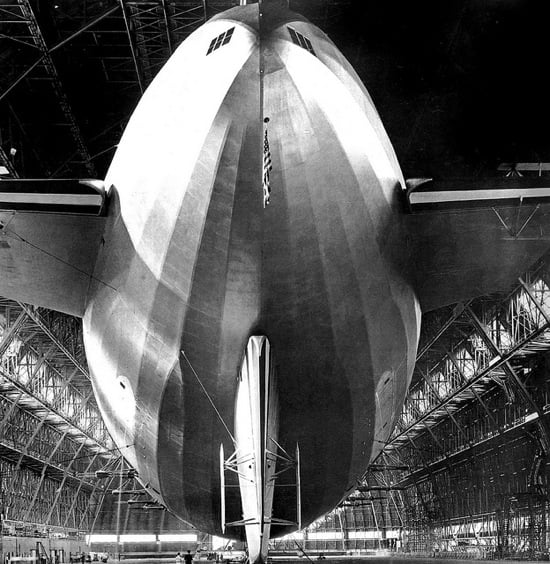
The eye detects no joint in her skin plating save the sweeping hair-crack of the bow-rudder —Magniac’s rudder that assured us the dominion of the unstable air and left its inventor penniless and half-blind. It is calculated to Castelli’s “gull-wing” curve. Raise a few feet of that all but invisible plate three-eighths of an inch and she will yaw five miles to port or starboard ere she is under control again. Give her full helm and she returns on her track like a whip-lash. Cant the whole forward — a touch on the wheel will suffice — and she sweeps at your good direction up or down. Open the complete circle and she presents to the air a mushroom-head that will bring her up all standing within a half mile.
“Yes,” says Captain Hodgson, answering my thought, “Castelli thought he’d discovered the secret of controlling aëroplanes when he’d only found out how to steer dirigible balloons. Magniac invented his rudder to help war-boats ram each other; and war went out of fashion and Magniac he went out of his mind because he said he couldn’t serve his country any more. I wonder if any of us ever know what we’re really doing.”
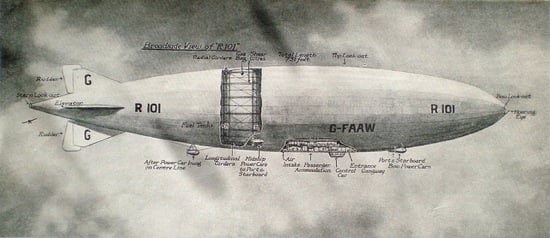
“If you want to see the coach locked you’d better go aboard. It’s due now,” says Mr. Geary. I enter through the door amidships. There is nothing here for display. The inner skin of the gas-tanks comes down to within a foot or two of my head and turns over just short of the turn of the bilges. Liners and yachts disguise their tanks with decoration, but the G. P. O. serves them raw under a lick of gray official paint. The inner skin shuts off fifty feet of the bow and as much of the stern, but the bow-bulkhead is recessed for the lift-shunting apparatus as the stern is pierced for the shaft-tunnels. The engine-room lies almost amidships. Forward of it, extending to the turn of the bow tanks, is an aperture — a bottomless hatch at present — into which our coach will be locked. One looks down over the coamings three hundred feet to the despatching-caisson whence voices boom upward. The light below is obscured to a sound of thunder, as our coach rises on its guides. It enlarges rapidly from a postage-stamp to a playing-card; to a punt and last a pontoon. The two clerks, its crew, do not even look up as it comes into place. The Quebec letters fly under their fingers and leap into the docketed racks, while both captains and Mr. Geary satisfy themselves that the coach is locked home. A clerk passes the waybill over the hatch-coaming. Captain Purnall thumb-marks and passes it to Mr. Geary. Receipt has been given and taken. “Pleasant run,” says Mr. Geary, and disappears through the door which a foot-high pneumatic compressor locks after him.
“A-ah!” sighs the compressor released. Our holding-down clips part with a tang. We are clear.
Captain Hodgson opens the great colloid underbody-porthole through which I watch million-lighted London slide eastward as the gale gets hold of us. The first of the low winter clouds cuts off the well-known view and darkens Middlesex. On the south edge of it I can see a postal packet’s light ploughing through the white fleece. For an instant she gleams like a star ere she drops toward the Highgate Receiving Towers. “The Bombay Mail,” says Captain Hodgson, and looks at his watch. “She’s forty minutes late.”
“What’s our level?” I ask.
“Four thousand. Aren’t you coming up on the bridge?”
The bridge (let us ever bless the G. P. O. as a repository of ancientest tradition!) is represented by a view of Captain Hodgson’s legs where he stands on the control platform that runs thwartships overhead. The bow colloid is unshuttered and Captain Purnall, one hand on the wheel, is feeling for a fair slant. The dial shows 4,300 feet.
“It’s steep to-night,” he mutters, as tier on tier of cloud drops under. “We generally pick up an easterly draught below three thousand at this time o’ the year. I hate slathering through fluff.”
“So does Van Cutsem. Look at him huntin’ for a slant!” says Captain Hodgson. A fog-light breaks cloud a hundred fathoms below. The Antwerp Night Mail makes her signal and rises between two racing clouds far to port, her flanks blood-red in the glare of Sheerness Double Light. The gale will have us over the North Sea in half an hour, but Captain Purnall lets her go composedly — nosing to every point of the compass as she rises.
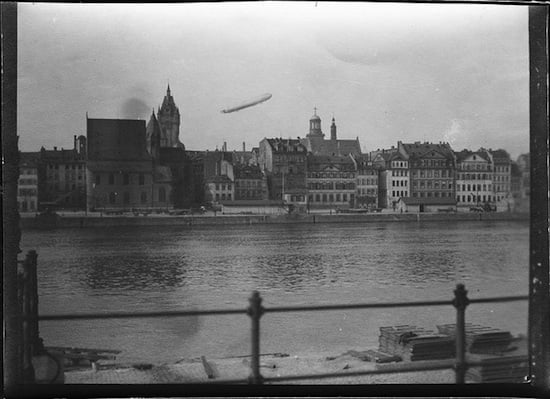
“Five thousand — six, six thousand eight hundred”— the dip-dial reads ere we find the easterly drift, heralded by a flurry of snow at the thousand-fathom level. Captain Purnall rings up the engines and keys down the governor on the switch before him. There is no sense in urging machinery when Æolus himself gives you good knots for nothing. We are away in earnest now — our nose notched home on our chosen star. At this level the lower clouds are laid out all neatly combed by the dry fingers of the East. Below that again is the strong westerly blow through which we rose. Overhead, a film of southerly drifting mist draws a theatrical gauze across the firmament. The moonlight turns the lower strata to silver without a stain except where our shadow underruns us. Bristol and Cardiff Double Lights (those statelily inclined beams over Severnmouth) are dead ahead of us; for we keep the Southern Winter Route. Coventry Central, the pivot of the English system, stabs upward once in ten seconds its spear of diamond light to the north; and a point or two off our starboard bow The Leek, the great cloud-breaker of Saint David’s Head, swings its unmistakable green beam twenty-five degrees each way. There must be half a mile of fluff over it in this weather, but it does not affect The Leek.
“Our planet’s overlighted if anything,” says Captain Purnall at the wheel, as Cardiff-Bristol slides under. “I remember the old days of common white verticals that ’ud show two or three thousand feet up in a mist, if you knew where to look for ’em. In really fluffy weather they might as well have been under your hat. One could get lost coming home then, an’ have some fun. Now, it’s like driving down Piccadilly.”
He points to the pillars of light where the cloud-breakers bore through the cloud-floor. We see nothing of England’s outlines: only a white pavement pierced in all directions by these manholes of variously coloured fire —Holy Island’s white and red —St. Bee’s interrupted white, and so on as far as the eye can reach. Blessed be Sargent, Ahrens, and the Dubois brothers, who invented the cloud-breakers of the world whereby we travel in security!
“Are you going to lift for The Shamrock?” asks Captain Hodgson. Cork Light (green, fixed) enlarges as we rush to it. Captain Purnall nods. There is heavy traffic hereabouts — the cloud-bank beneath us is streaked with running fissures of flame where the Atlantic boats are hurrying Londonward just clear of the fluff. Mail-packets are supposed, under the Conference rules, to have the five-thousand-foot lanes to themselves, but the foreigner in a hurry is apt to take liberties with English air. “No. 162” lifts to a long-drawn wail of the breeze in the fore-flange of the rudder and we make Valencia (white, green, white) at a safe 7,000 feet, dipping our beam to an incoming Washington packet.
There is no cloud on the Atlantic, and faint streaks of cream round Dingle Bay show where the driven seas hammer the coast. A big S. A. T. A. liner (Société Anonyme des Transports Aëriens) is diving and lifting half a mile below us in search of some break in the solid west wind. Lower still lies a disabled Dane: she is telling the liner all about it in International. Our General Communication dial has caught her talk and begins to eavesdrop. Captain Hodgson makes a motion to shut it off but checks himself. “Perhaps you’d like to listen,” he says.
“‘Argol’ of St. Thomas,” the Dane whimpers. “Report owners three starboard shaft collar-bearings fused. Can make Flores as we are, but impossible further. Shall we buy spares at Fayal?”
The liner acknowledges and recommends inverting the bearings. The “Argol” answers that she has already done so without effect, and begins to relieve her mind about cheap German enamels for collar-bearings. The Frenchman assents cordially, cries “Courage, mon ami,” and switches off.
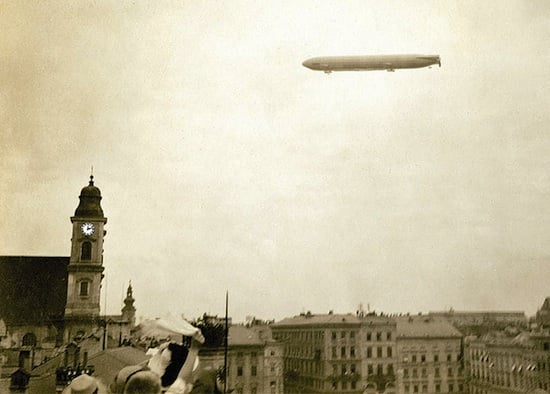
Their lights sink under the curve of the ocean.
“That’s one of Lundt & Bleamers’s boats,” says Captain Hodgson. “Serves ’em right for putting German compos in their thrust-blocks. She won’t be in Fayal to-night! By the way, wouldn’t you like to look round the engine-room?”
NEXT WEEK: “The jointed U-tubes of the vacuum-chamber are pressure-tempered colloid (no glass would endure the strain for an instant) and a junior engineer with tinted spectacles watches the Ray intently. It is the very heart of the machine — a mystery to this day.”
RADIUM AGE SCIENCE FICTION: “Radium Age” is HILOBROW’s name for the 1904–33 era, which saw the discovery of radioactivity, the revelation that matter itself is constantly in movement — a fitting metaphor for the first decades of the 20th century, during which old scientific, religious, political, and social certainties were shattered. This era also saw the publication of genre-shattering writing by Edgar Rice Burroughs, Sax Rohmer, E.E. “Doc” Smith, Jack London, Arthur Conan Doyle, Aldous Huxley, Olaf Stapledon, Karel Čapek, H.P. Lovecraft, Charlotte Perkins Gilman, Yevgeny Zamyatin, Philip Gordon Wylie, and other pioneers of post-Verne/Wells, pre-Golden Age “science fiction.” More info here.
HILOBOOKS: The mission of HiLoBooks is to serialize novels on HiLobrow; and also, as of 2012, operating as an imprint of Richard Nash’s Cursor, to reissue Radium Age science fiction in beautiful new print editions. So far, we have published Jack London’s The Scarlet Plague, Rudyard Kipling’s With the Night Mail (and “As Easy as A.B.C.”), Arthur Conan Doyle’s The Poison Belt, H. Rider Haggard’s When the World Shook, Edward Shanks’s The People of the Ruins, William Hope Hodgson’s The Night Land, and J.D. Beresford’s Goslings. Forthcoming: E.V. Odle’s The Clockwork Man, Cicely Hamilton’s Theodore Savage, and Muriel Jaeger’s The Man with Six Senses. For more information, visit the HiLoBooks homepage.
READ: You are reading Rudyard Kipling’s With the Night Mail and “As Easy As A.B.C.” Also read our serialization of: Jack London’s The Scarlet Plague | H. Rider Haggard’s When The World Shook
ORIGINAL FICTION: HILOBROW has serialized three novels: James Parker’s The Ballad of Cocky The Fox (“a proof-of-concept that serialization can work on the Internet” — The Atlantic) and Karinne Keithley Syers’s Linda Linda Linda. We also publish original stories and comics.
